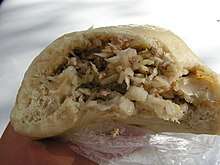Pyanse
Pyanse (Russian: пянсе) or pigodi (Russian: пигоди, sg. pigodya пигодя) is a Russo-Korean steamed pie, bun, or dumpling stuffed with cabbage and meat.[1][2] It is a popular dish in Russian Far East, as well as in Koryo-saram communities of Central Asia.[3][4]
 | |
| Alternative names | Pigodi |
|---|---|
| Type | |
| Course | |
| Place of origin | Russia |
| Region or state | Sakhalin |
| Created by | Sakhalin Koreans |
| Invented | Early 1980s |
| Similar dishes | |
Etymology
The Russian word pigodi (пигоди, plural) derived from pigodya (пигодя, singular), which is the Russian transcription of the Koryo-mar word begoja (베고자).[5]
History
Pyanse is said to have first made in Kholmsk, Russia by Sakhalin Koreans in the early 1980s, as an adaptation of Korean wang-mandu ("king dumpling").[1][2][6] It has been the most popular street food in Vladivostok since the early 1990s, and became popular in Moscow in the 2010s.[1]
gollark: Enjoy your safety!
gollark: It seems like a bad tradeoff at this point.
gollark: The US situation with the AstraZeneca vaccine just seems bizarre and ridiculous. They're holding off on approving it because ??? and just having it sit there where nobody can use it. Whatever bureaucracy is going on is basically killing people (indirectly).
gollark: Was it *that* wrong apart from the US?
gollark: "Uniform" in a somewhat loose sense, but they require ties and such.
See also
References
- Rossiyskaya Gazeta (25 June 2016). "What's hot about pyanse, Vladivostok's most popular street food". Russia Beyond. Retrieved 8 February 2018.
- Muchnik, Andrei (24 October 2016). "Moscow Restaurants: Koryo-saram at K-Town". The Moscow Times. Retrieved 8 February 2018.
- Richmond, Simon; Bennetts, Marc; Duca, Marc Di; Haywood, Anthony; Kaminski, Anna; Masters, Tom; Sheward, Tamara; Louis, Regis St; Vorhees, Mara (2015). Lonely Planet Russia. Lonely Planet. p. 625. ISBN 978-1-74220-733-9. Retrieved 8 February 2018.
- Kim, Victoria. "Lost and Found in Uzbekistan: The Korean Story, Part 1". The Diplomat. Retrieved 8 February 2018.
- 윤영수. "고려인 이주 80주년 특별기획 - 사샤의 아리랑". KBS (in Korean).
- Kamalakaran, Ajay (1 July 2016). "Russo-Korean cuisine: 7 delicacies from the Russian Far East". Russia Beyond. Retrieved 8 February 2018.
This article is issued from Wikipedia. The text is licensed under Creative Commons - Attribution - Sharealike. Additional terms may apply for the media files.